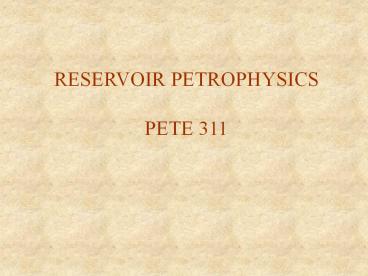RESERVOIR PETROPHYSICS - PowerPoint PPT Presentation
1 / 27
Title:
RESERVOIR PETROPHYSICS
Description:
reservoir petrophysics pete 311 sedimentary rock types generation, migration, and trapping of hydrocarbons sedimentary rock types generation, migration, and trapping ... – PowerPoint PPT presentation
Number of Views:1210
Avg rating:3.0/5.0
Title: RESERVOIR PETROPHYSICS
1
RESERVOIR PETROPHYSICS PETE 311
2
PETROPHYSICS
Petrophysics is the study of rock properties and
rock interactions with fluids (gases, liquid
hydrocarbons, and aqueous solutions).
Modified from Tiab and Donaldson, 1996, p. 1
3
RESERVOIR PETROPHYSICS PETE 311 COURSE
DESCRIPTION
- Systematic theoretical and laboratory study of
physical properties of petroleum reservoir rocks - Lithology
- Porosity
- Compressibility
- Permeability
- Fluid saturations
- Capillary characteristics
- Rock stress
- Fluid-rock interaction
4
- RESERVOIR PETROPHYSICS
- Course Objectives
- By the last day of class, the student should be
able to - Define porosity discuss the factors which effect
porosity and describe the methods of determining
values of porosity - Define the coefficient of isothermal
compressibility of reservoir rock and describe
methods for determining values of formation
compressibility - Reproduce the Darcy equation in differential
form, explain its meaning, integrate the equation
for typical reservoir systems, discuss and
calculate the effect of fractures and channels,
and describe methods for determining values of
absolute permeability
5
- RESERVOIR PETROPHYSICS
- Course Objectives
- Explain boundary tension and wettability and
their effect on capillary pressure, describe
methods of determining values of capillary
pressure, and convert laboratory capillary
pressure values to reservoir conditions - Describe methods of determining fluid saturations
in reservoir rock and show relationship between
fluid saturation and capillary pressure - Define resistivity, electrical formation
resistivity factor, resistivity index, saturation
exponent, and cementation factor and show their
relationship and uses discuss laboratory
measurement of electrical properties of reservoir
rocks and demonstrate the calculations necessary
in analyzing laboratory measurements
6
- RESERVOIR PETROPHYSICS
- Course Objectives
- Define effective permeability, relative
permeability, permeability ratio reproduce
typical relative permeability curves and show
effect of saturation history on relative
permeability illustrate the measurement of
relative permeability and demonstrate some uses
of relative permeability data. - Describe three-phase flow in reservoir rock and
explain methods of displaying three-phase
effective permeabilities. - Demonstrate the techniques of averaging porosity,
permeability, and reservoir pressure data. - Demonstrate capability to perform calculations
relating to all concepts above. - (These are minimum skills to be
achieved/demonstrated)
7
PETROPHYSICS
- Why do we study petrophysics?
8
Cross Section Of A Petroleum System
(Foreland Basin Example)
9
PETROLEUM SYSTEM
From Schlumberger Oilfield Glossary
Timing of formation of the major elements of a
petroleum system, Maracaibo basin, Venezuela.
10
DEFINITIONS - SEDIMENTARY ROCK
11
CLASTIC AND CARBONATE ROCKS
12
SEDIMENTARY ROCK TYPES
Relative Abundances
13
Grain-Size Classification for Clastic Sediments
14
DUNHAMS CLASSIFICATION - CARBONATES
Carbonate rocks can be classified according to
the texture and grain size.
From Schlumberger Oilfield Glossary
15
GENERATION, MIGRATION, AND TRAPPING OF
HYDROCARBONS
Seal
Seal
Top of maturity
16
DESCRIBING A RESERVOIR
Structural Characterization
17
STRUCTURAL HYDROCARBON TRAP
This structural trap is formed by an anticline
and a normal fault.
From Schlumberger Oilfield Glossary
18
DOMAL TRAP
- Are hydrocarbons in this field oil or gas?
- What is the volume of hydrocarbons
- In this trap?
- What are the reserves?
Closure. In map view (top), closure is the area
within the deepest structural contour that forms
a trapping geometry, in this case 1300 ft 390
m. In cross section A-A', closure is the
vertical distance from the top of the structure
to the lowest closing contour, in this case about
350 ft 105 m. The point beyond which
hydrocarbons could leak from or migrate beyond
the trap is the spill point.
From Schlumberger Oilfield Glossary
19
WATER DRIVE
What is the Drive Mechanism?
A reservoir-drive mechanism whereby the oil is
driven through the reservoir by an active
aquifer. As the reservoir depletes, the water
moving in from the aquifer below displaces the
oil until the aquifer energy is expended or the
well eventually produces too much water to be
viable.
From Schlumberger Oilfield Glossary
20
GAS EXPANSION DRIVE
What is the Drive Mechanism?
A gas-drive system utilizes the energy of the
reservoir gas, identifiable as either as free or
solution gas, to produce reservoir liquids.
Are there other drive mechanisms?
From Schlumberger Oilfield Glossary
21
TYPES OF HYDROCARBONS
- Composition
- Molecular structure
- Physical properties
22
PHYSICAL PROPERTIES OF HYDROCARBONS
- Color
- Refractive Index
- Odor
- Density (Specific Gravity)
- Boiling Point
- Freezing Point
- Flash Point
- Viscosity
23
FLUID DENSITY
24
FLUID VISCOSITY
- Importance
- Units centipoises (µ, cp)
- Strongly temperature dependent
- Standard reporting conditions
25
DRILLING RIGS
Drillship
Jackup
Submersible
Land Rig
Semisubmersible
From Schlumberger Oilfield Glossary
26
ROTARY DRILL BIT, WORN
From Schlumberger Oilfield Glossary
27
Next Class
- RESERVOIR POROSITY
- Definition Porosity is the fraction of a rock
that is occupied by voids (pores). - Origins and descriptions
- Factors that effect porosity
- Methods of determination































